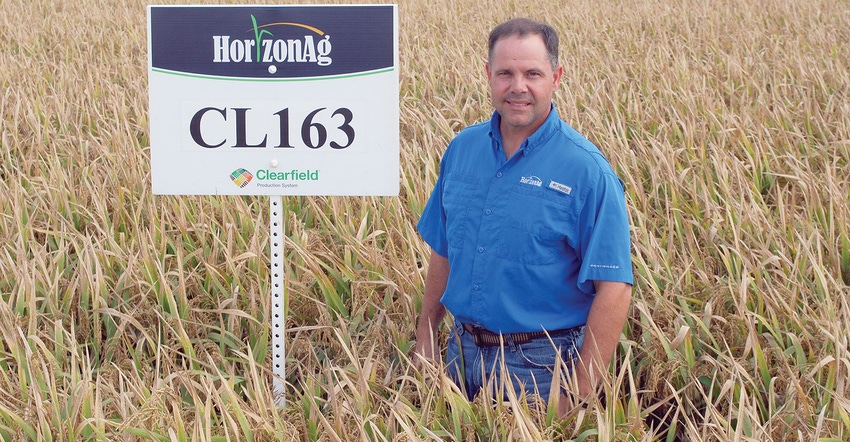
Before the recent Horizon Ag Rice Field Day in Kaplan, La., Delta Farm Press sat down with Dr. Tim Walker, general manager of Horizon Ag, to discuss weedy rice (red rice), the new Provisia Rice System, and how it will impact U.S. rice production in 2018 and beyond.
Back in the late 1990s, five independent seed companies merged to form Horizon Ag with the intent to deliver Clearfield rice varieties to the market. The Clearfield Production System became commercially available in 2001 with pure-line varieties developed by the Louisiana State University AgCenter. Since those first releases, Horizon Ag has also marketed varieties developed by Mississippi State University and the University of Arkansas.
The system saw widespread adoption because it gave producers a way to control red rice in commercial rice production. “Since then, continuous rice plantings year after year, along with outcrossing and volunteer Clearfield F2s from Clearfield hybrid production, created what is being called weedy rice,” says Walker. “As with any technology, resistance has developed in some areas — some worse than others.”
Work began in the late 2000s to develop a new rice technology system that would not only complement the Clearfield system, but also give growers a tool to control weedy rice. The Provisia Rice System was launched this year, providing a different mode of action and effectively controlling the weedy rice complex.
“We’ve seen more problems with weedy rice in southeast Arkansas, south Louisiana, and far northeast Arkansas, where growers practice continuous rice production,” says Walker. “Despite those pocketed problem areas, the Clearfield system is still very effective in over 70 percent of overall U.S. rice acres where we believe grower stewardship of the technology (like rotation and other herbicide use) has extended the life of the Clearfield technology.”
The Message
Although Walker and his technical staff showcased the first variety released and tolerant to Provisia herbicide, PVL01, they reiterated they are not moving past the Clearfield system, and, in fact, have new rice varieties in the development pipeline to be launched over the next few years.
Growers in attendance wanted to hear about anything they might need to be aware of regarding Provisia, especially as their rice is nearing or at heading. “I’m sure they all want to hear how PVL01 is performing in our trials, up-to-date yield data, and how it is grading at the mill,” adds Walker.
As with any new technologies, there have been bumps in the road implementing the technology. After an initial application of Provisia early in the season, some yellowing of leaves occurred, or plant stunting was seen.
“This crop response may have set some plants back a little, but in the areas where we saw that occurring, they recovered rapidly,” adds Walker. “You could tell then that herbicide had been applied, but you can’t tell it today. There should be no impact to yield potential.”
Weedy Rice and Acres
Before the Clearfield system, there were no herbicides to combat red rice. Cultural practices like water-seeding, crop rotation, or working the soil in mud were used. Sometimes they were ineffective and sometimes they were not. Once Clearfield hit the market, growers in south Louisiana could transition to the drill-seed, delayed flood production culture that was commonly used in the Mississippi Delta, and the Grand Prairie — two high-yielding rice production areas.
Walker mentioned that landowners who may have found it difficult to rent their land for rice production with uncontrollable red rice seed banks, now have an option to bring that land back into production.
“Growers farming with crop loans who have to show their crop to bankers may feel better about the aesthetics of their rice crop,” explains Walker.
Rice acres in the U.S. are down and have been trending in that direction, while U.S. rice imports continue to trend upward. “We’re on track to import the equivalent of 400,000 acres of rice this year and that’s alarming,” says Walker. “We import mostly from Thailand and India, but more and more we are importing rice from areas like South America that is very similar to the type of rice we grow here in the U.S.”
Reports from PVL01 show it has excellent grain quality, very low chalk, and good length — characteristics important to high-end customers in central America. “PVL01, along with our newer Clearfield lines like CL153 and CL172, address many of the problems associated with quality that the southern U.S. rice industry faces currently,” says Walker.
Horizon Ag has been sounding the bell of stewardship loudly. With a very telling case of how a technology (i.e., Clearfield) can develop resistance, we’re doing everything we can to educate growers on the need for understanding, establishing, and stewarding correct crop rotations,” adds Walker.
Eighteen years separated the commercial launch of Clearfield and this year’s launch of Provisia. Walker knows it usually takes 10 years from the time you hear about a new technology until it becomes commercially available.
“We’re not hearing about any other new technologies at this point, so we are stressing to growers that everyone has to be a good steward of this technology for it to remain a viable tool they can use down the road,” says Walker.
About the Author(s)
You May Also Like




